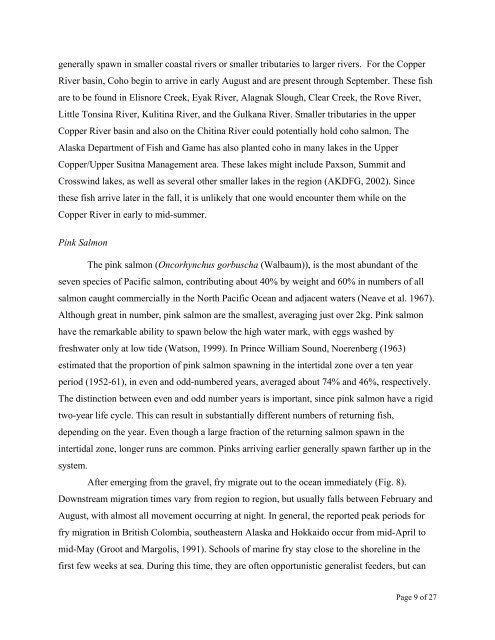Life Histories and Distributions of Copper River Fishes (.pdf)
Life Histories and Distributions of Copper River Fishes (.pdf)
Life Histories and Distributions of Copper River Fishes (.pdf)
Create successful ePaper yourself
Turn your PDF publications into a flip-book with our unique Google optimized e-Paper software.
generally spawn in smaller coastal rivers or smaller tributaries to larger rivers. For the <strong>Copper</strong><strong>River</strong> basin, Coho begin to arrive in early August <strong>and</strong> are present through September. These fishare to be found in Elisnore Creek, Eyak <strong>River</strong>, Alagnak Slough, Clear Creek, the Rove <strong>River</strong>,Little Tonsina <strong>River</strong>, Kulitina <strong>River</strong>, <strong>and</strong> the Gulkana <strong>River</strong>. Smaller tributaries in the upper<strong>Copper</strong> <strong>River</strong> basin <strong>and</strong> also on the Chitina <strong>River</strong> could potentially hold coho salmon. TheAlaska Department <strong>of</strong> Fish <strong>and</strong> Game has also planted coho in many lakes in the Upper<strong>Copper</strong>/Upper Susitna Management area. These lakes might include Paxson, Summit <strong>and</strong>Crosswind lakes, as well as several other smaller lakes in the region (AKDFG, 2002). Sincethese fish arrive later in the fall, it is unlikely that one would encounter them while on the<strong>Copper</strong> <strong>River</strong> in early to mid-summer.Pink SalmonThe pink salmon (Oncorhynchus gorbuscha (Walbaum)), is the most abundant <strong>of</strong> theseven species <strong>of</strong> Pacific salmon, contributing about 40% by weight <strong>and</strong> 60% in numbers <strong>of</strong> allsalmon caught commercially in the North Pacific Ocean <strong>and</strong> adjacent waters (Neave et al. 1967).Although great in number, pink salmon are the smallest, averaging just over 2kg. Pink salmonhave the remarkable ability to spawn below the high water mark, with eggs washed byfreshwater only at low tide (Watson, 1999). In Prince William Sound, Noerenberg (1963)estimated that the proportion <strong>of</strong> pink salmon spawning in the intertidal zone over a ten yearperiod (1952-61), in even <strong>and</strong> odd-numbered years, averaged about 74% <strong>and</strong> 46%, respectively.The distinction between even <strong>and</strong> odd number years is important, since pink salmon have a rigidtwo-year life cycle. This can result in substantially different numbers <strong>of</strong> returning fish,depending on the year. Even though a large fraction <strong>of</strong> the returning salmon spawn in theintertidal zone, longer runs are common. Pinks arriving earlier generally spawn farther up in thesystem.After emerging from the gravel, fry migrate out to the ocean immediately (Fig. 8).Downstream migration times vary from region to region, but usually falls between February <strong>and</strong>August, with almost all movement occurring at night. In general, the reported peak periods forfry migration in British Colombia, southeastern Alaska <strong>and</strong> Hokkaido occur from mid-April tomid-May (Groot <strong>and</strong> Margolis, 1991). Schools <strong>of</strong> marine fry stay close to the shoreline in thefirst few weeks at sea. During this time, they are <strong>of</strong>ten opportunistic generalist feeders, but canPage 9 <strong>of</strong> 27
















